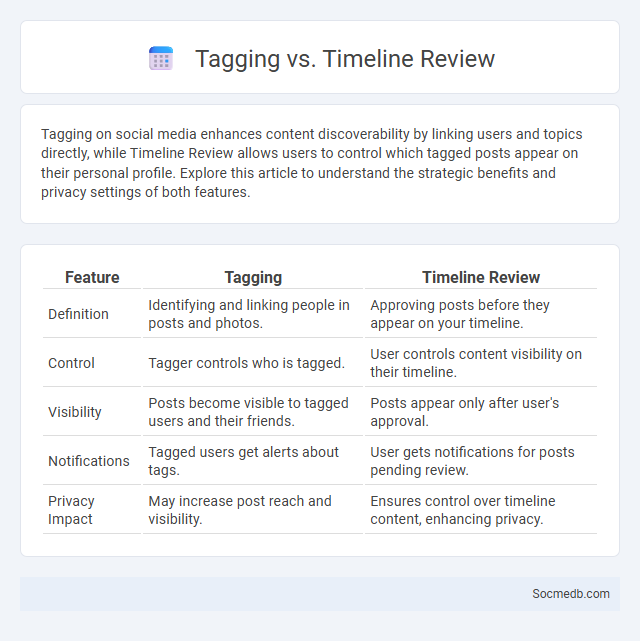
Photo illustration: Tagging vs Timeline Review
Tagging on social media enhances content discoverability by linking users and topics directly, while Timeline Review allows users to control which tagged posts appear on their personal profile. Explore this article to understand the strategic benefits and privacy settings of both features.
Table of Comparison
| Feature | Tagging | Timeline Review |
|---|---|---|
| Definition | Identifying and linking people in posts and photos. | Approving posts before they appear on your timeline. |
| Control | Tagger controls who is tagged. | User controls content visibility on their timeline. |
| Visibility | Posts become visible to tagged users and their friends. | Posts appear only after user's approval. |
| Notifications | Tagged users get alerts about tags. | User gets notifications for posts pending review. |
| Privacy Impact | May increase post reach and visibility. | Ensures control over timeline content, enhancing privacy. |
Introduction to Tagging, Timeline Review, and Tagging
Tagging on social media enables users to link friends, brands, or topics directly in posts, enhancing visibility and engagement. The timeline review feature allows users to approve or reject tags before they appear, maintaining control over their personal content. Effective tagging strategies increase reach by connecting relevant audiences and facilitating content discovery across platforms.
What is Tagging?
Tagging on social media involves labeling or identifying people, brands, or topics in posts, photos, or comments to increase visibility and engagement. This feature helps users connect content to specific profiles, making it easier to search, organize, and share relevant information. Tagging also enhances interaction by notifying tagged users and expanding the content's reach across networks.
Understanding Timeline Review
Timeline Review on social media enables users to monitor and manage posts and tags appearing on their profiles, ensuring content aligns with their online image. This feature allows customization of who can see posts and the ability to approve or reject tagged content before it becomes visible. Effective use of Timeline Review enhances privacy control and maintains a positive digital presence across platforms like Facebook and Instagram.
Differences Between Tagging and Timeline Review
Tagging on social media allows users to directly link friends or pages in posts, photos, or comments, creating visible connections that notify tagged individuals. Timeline review is a privacy tool enabling users to approve or reject posts and tags before they appear on their personal timeline, ensuring control over shared content. The key difference lies in tagging being an active inclusion mechanism, whereas timeline review functions as a content moderation feature to manage visibility.
Benefits of Using Tagging
Tagging on social media enhances content visibility by connecting your posts to relevant topics, locations, and users, increasing engagement and reach. It helps organize and categorize content, making it easier for your audience to find and interact with your posts. Using tags strategically boosts your online presence and fosters stronger community interactions.
Advantages of Timeline Review
Timeline review on social media enables users to revisit past posts, enhancing memory recall and personal reflection. It improves content organization by allowing chronological browsing, making it easier to locate specific memories or events. Businesses and influencers benefit from timeline review by analyzing audience engagement trends and refining content strategies accordingly.
Use Cases for Tagging and Timeline Review
Tagging on social media enhances content organization by linking posts to relevant people, places, or topics, improving user engagement and searchability. Timeline review allows users to monitor and manage tagged content, ensuring privacy control and content accuracy. These features collectively enable efficient content discovery and personalized user experience on platforms like Facebook, Instagram, and Twitter.
Privacy Implications: Tagging vs Timeline Review
Social media tagging exposes personal information to wider audiences, increasing privacy risks by linking users to photos or posts without explicit consent. Timeline review features allow users to moderate tagged content before it appears publicly, providing greater control over their digital footprint. Balancing tagging convenience with timeline review functionality is essential for safeguarding user privacy on social platforms.
Best Practices for Effective Tag Management
Effective tag management on social media involves organizing and categorizing content with relevant, targeted hashtags to increase visibility and engagement. Utilizing a consistent tagging strategy tailored to the brand's niche enhances searchability and helps reach the intended audience more efficiently. Regularly analyzing hashtag performance through social media analytics tools allows optimization of tag usage for maximum impact across platforms.
Choosing the Right Feature: Tagging or Timeline Review
Choosing the right social media feature between tagging and timeline review depends on user control and privacy preferences. Tagging allows users to connect posts and photos with specific people, enhancing visibility and engagement, while timeline review enables users to approve content before it appears on their profile, offering greater moderation and privacy. Understanding the impact of each feature on personal branding and audience interaction is crucial for optimizing social media presence.
 socmedb.com
socmedb.com